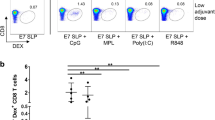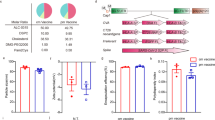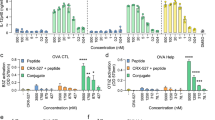Abstract
Developing a cancer vaccine with a potent adjuvant, which is safe for human use, remains to be an unmet need. In this study, we developed a simple, safe, yet efficient, peptide-based therapeutic cancer vaccine, DOTAP/E7 complex, which comprises only two molecules: a DOTAP cationic lipid and a peptide antigen derived from E7 oncoprotein of human papillomavirus (HPV) type 16. The anti-cancer activity of DOTAP/E7 against existing HPV positive TC-1 tumor was compared to that of our previous LPD/E7 formulation, which contains bacterial DNA CpG motifs. Tumor-bearing mice showed significant tumor inhibition following a single vaccination of either formulation at the optimal lipid dose, suggesting that DOTAP liposome alone can provide a potent adjuvant activity without plasmid DNA. E7 peptide formulated with DOTAP induced migration of activated dendritic cells (DC) to the draining lymph node (DLN) and efficiently generated functional antigen-specific CD8+ T lymphocyte responses. Accumulation of CD8+ tumor infiltrating T cells and apoptosis at tumor sites were observed after treatment with DOTAP/E7 complexes, which was also associated with a decreased amount of CD25+Foxp3+ regulatory T cells in treated animals. Reactive oxygen species (ROS) induced by DOTAP cationic lipid in DLN revealed a plausible mechanism of the initial interaction between DC and DOTAP. An adequate amount of ROS generation was apparently required for the initiation of the vaccine mechanism; however, an overdose of DOTAP induced massive ROS production and apoptosis of DC in DLN, which led to diminished anti-cancer immunity. Overall, these results indicate that cationic lipid DOTAP alone serves as an efficient vaccine adjuvant for the induction of a therapeutic, antigen-specific anti-cancer activity.







Similar content being viewed by others
Abbreviations
- LPD:
-
Liposome-polycations-DNA
- DLN:
-
Draining lymph node
- Treg:
-
Regulatory T cell
- DOTAP:
-
1,2-Dioleoyl-3-trimethylammonium propane
- NBD-DOTAP:
-
1-Oleoyl-2-[6-[(7-nitro-2-1,3-benzoxadiazol-4-yl)amino]hexanoyl]-3-trimethylammonium propane
- DOEPC:
-
1,2-Dioleoyl-sn-glycero-3-ethylphosphocholine
- DOTMA:
-
N-[1-(2,3-Dioleyloxy)propyl] -N,N,N-trimethylammonium chloride
- DOPG:
-
1,2-Dioleoyl-sn-glycero-3-[phospho-rac-(1-glycerol)]
- DOPC:
-
1,2-Dioleoyl-sn-glycero-3-phosphocholine
References
Gregoriadis G (1990) Immunological adjuvants: a role for liposomes. Immunol Today 11:89–97
Wang RF, Wang HY (2002) Enhancement of antitumor immunity by prolonging antigen presentation on dendritic cells. Nat Biotechnol 20:149–154
Vogel FR (2000) Improving vaccine performance with adjuvants. Clin Infect Dis 30(Suppl 3):S266–270
Vogel FR (1996) Role of adjuvants in HIV vaccine design. Antibiot Chemother 48:84–91
Baecher-Allan C, Anderson DE (2006) Immune regulation in tumor-bearing hosts. Curr Opin Immunol 18:214–219
Li S, Huang L (1997) In vivo gene transfer via intravenous administration of cationic lipid-protamine-DNA (LPD) complexes. Gene Ther 4:891–900
Chen WC, Huang L (2005) Non-viral vector as vaccine carrier. Adv Genet 54:315–337
Whitmore M, Li S, Huang L (1999) LPD lipopolyplex initiates a potent cytokine response and inhibits tumor growth. Gene Ther 6:1867–1875
Whitmore MM, Li S, Falo L Jr, Huang L (2001) Systemic administration of LPD prepared with CpG oligonucleotides inhibits the growth of established pulmonary metastases by stimulating innate and acquired antitumor immune responses. Cancer Immunol Immunother 50:503–514
Ishii KJ, Kawakami K, Gursel I, Conover J, Joshi BH, Klinman DM, Puri RK (2003) Antitumor therapy with bacterial DNA and toxin: complete regression of established tumor induced by liposomal CpG oligodeoxynucleotides plus interleukin-13 cytotoxin. Clin Cancer Res 9:6516–6522
Hemmi H, Takeuchi O, Kawai T, Kaisho T, Sato S, Sanjo H, Matsumoto M, Hoshino K, Wagner H, Takeda K, Akira S (2000) A Toll-like receptor recognizes bacterial DNA. Nature 408:740–745
Klinman DM (2003) CpG DNA as a vaccine adjuvant. Expert Rev Vaccines 2:305–315
Marciani DJ (2003) Vaccine adjuvants: role and mechanisms of action in vaccine immunogenicity. Drug Discov Today 8:934–943
Jiang ZH, Koganty RR (2003) Synthetic vaccines: the role of adjuvants in immune targeting. Curr Med Chem 10:1423–1439
Cui Z, Huang L (2005) Liposome-polycation-DNA (LPD) particle as a carrier and adjuvant for protein-based vaccines: therapeutic effect against cervical cancer. Cancer Immunol Immunother 54:1180–1190
Cui Z, Han SJ, Vangasseri DP, Huang L (2005) Immunostimulation mechanism of LPD nanoparticle as a vaccine carrier. Mol Pharm 2:22–28
Dileo J, Banerjee R, Whitmore M, Nayak JV, Falo LD Jr, Huang L (2003) Lipid-protamine-DNA-mediated antigen delivery to antigen-presenting cells results in enhanced anti-tumor immune responses. Mol Ther 7:640–648
Vangasseri DP, Cui Z, Chen W, Hokey DA, Falo LD, Huang L (2006) Immunostimulation of dendritic cells by cationic liposomes. Mol Membr Biol 23:385–395
Yan W, Chen W, Huang L (2007) Mechanism of adjuvant activity of cationic liposome: phosphorylation of a MAP kinase, ERK and induction of chemokines. Mol Immunol 44:3672–3681
Gursel I, Gursel M, Ishii KJ, Klinman DM (2001) Sterically stabilized cationic liposomes improve the uptake and immunostimulatory activity of CpG oligonucleotides. J Immunol 167:3324–3328
Zaks K, Jordan M, Guth A, Sellins K, Kedl R, Izzo A, Bosio C, Dow S (2006) Efficient immunization and cross-priming by vaccine adjuvants containing TLR3 or TLR9 agonists complexed to cationic liposomes. J Immunol 176:7335–7345
Byers AM, Kemball CC, Moser JM, Lukacher AE (2003) Cutting edge: rapid in vivo CTL activity by polyoma virus-specific effector and memory CD8+ T cells. J Immunol 171:17–21
Hempel SL, Buettner GR, O’Malley YQ, Wessels DA, Flaherty DM (1999) Dihydrofluorescein diacetate is superior for detecting intracellular oxidants: comparison with 2′,7′-dichlorodihydrofluorescein diacetate, 5(and 6)-carboxy-2′,7′-dichlorodihydrofluorescein diacetate, and dihydrorhodamine 123. Free Radic Biol Med 27:146–159
Tan Y, Liu F, Li Z, Li S, Huang L (2001) Sequential injection of cationic liposome and plasmid DNA effectively transfects the lung with minimal inflammatory toxicity. Mol Ther 3:673–682
Yew NS, Scheule RK (2005) Toxicity of cationic lipid–DNA complexes. Adv Genet 53:189–214
Zou W (2006) Regulatory T cells, tumour immunity and immunotherapy. Nat Rev Immunol 6:295–307
Wu J, Lanier LL (2003) Natural killer cells and cancer. Adv Cancer Res 90:127–156
Lodoen MB, Lanier LL (2006) Natural killer cells as an initial defense against pathogens. Curr Opin Immunol 18:391–398
Boehm U, Klamp T, Groot M, Howard JC (1997) Cellular responses to interferon-gamma. Annu Rev Immunol 15:749–795
Matsue H, Edelbaum D, Shalhevet D, Mizumoto N, Yang C, Mummert ME, Oeda J, Masayasu H, Takashima A (2003) Generation and function of reactive oxygen species in dendritic cells during antigen presentation. J Immunol 171:3010–3018
Iwaoka S, Nakamura T, Takano S, Tsuchiya S, Aramaki Y (2006) Cationic liposomes induce apoptosis through p38 MAP kinase-caspase-8-Bid pathway in macrophage-like RAW264.7 cells. J Leukoc Biol 79:184–191
Enoch HG, Strittmatter P (1979) Formation and properties of 1000-A-diameter, single-bilayer phospholipid vesicles. Proc Natl Acad Sci USA 76:145–149
Hagensee ME, Olson NH, Baker TS, Galloway DA (1994) Three-dimensional structure of vaccinia virus-produced human papillomavirus type 1 capsids. J Virol 68:4503–4505
Chen XS, Garcea RL, Goldberg I, Casini G, Harrison SC (2000) Structure of small virus-like particles assembled from the L1 protein of human papillomavirus 16. Mol Cell 5:557–567
Kirnbauer R, Booy F, Cheng N, Lowy DR, Schiller JT (1992) Papillomavirus L1 major capsid protein self-assembles into virus-like particles that are highly immunogenic. Proc Natl Acad Sci USA 89:12180–12184
Christensen ND, Hopfl R, DiAngelo SL, Cladel NM, Patrick SD, Welsh PA, Budgeon LR, Reed CA, Kreider JW (1994) Assembled baculovirus-expressed human papillomavirus type 11 L1 capsid protein virus-like particles are recognized by neutralizing monoclonal antibodies and induce high titres of neutralizing antibodies. J Gen Virol 75(Pt 9):2271–2276
Vogel FR, Powell MF (1995) A compendium of vaccine adjuvants and excipients. Pharm Biotechnol 6:141–228
Gluck R, Walti E (2000) Biophysical validation of Epaxal Berna, a hepatitis A vaccine adjuvanted with immunopotentiating reconstituted influenza virosomes (IRIV). Dev Biol (Basel) 103:189–197
Kahn JO, Sinangil F, Baenziger J, Murcar N, Wynne D, Coleman RL, Steimer KS, Dekker CL, Chernoff D (1994) Clinical and immunologic responses to human immunodeficiency virus (HIV) type 1SF2 gp120 subunit vaccine combined with MF59 adjuvant with or without muramyl tripeptide dipalmitoyl phosphatidylethanolamine in non-HIV-infected human volunteers. J Infect Dis 170:1288–1291
Dupuis M, Murphy TJ, Higgins D, Ugozzoli M, van Nest G, Ott G, McDonald DM (1998) Dendritic cells internalize vaccine adjuvant after intramuscular injection. Cell Immunol 186:18–27
Jones CA, Cunningham AL (2004) Vaccination strategies to prevent genital herpes and neonatal herpes simplex virus (HSV) disease. Herpes 11:12–17
Minutello M, Senatore F, Cecchinelli G, Bianchi M, Andreani T, Podda A, Crovari P (1999) Safety and immunogenicity of an inactivated subunit influenza virus vaccine combined with MF59 adjuvant emulsion in elderly subjects, immunized for three consecutive influenza seasons. Vaccine 17:99–104
Pashine A, Valiante NM, Ulmer JB (2005) Targeting the innate immune response with improved vaccine adjuvants. Nat Med 11:S63–68
Evans JT, Cluff CW, Johnson DA, Lacy MJ, Persing DH, Baldridge JR (2003) Enhancement of antigen-specific immunity via the TLR4 ligands MPL adjuvant and Ribi.529. Expert Rev Vaccines 2:219–229
Kantengwa S, Jornot L, Devenoges C, Nicod LP (2003) Superoxide anions induce the maturation of human dendritic cells. Am J Respir Crit Care Med 167:431–437
Tobiume K, Matsuzawa A, Takahashi T, Nishitoh H, Morita K, Takeda K, Minowa O, Miyazono K, Noda T, Ichijo H (2001) ASK1 is required for sustained activations of JNK/p38 MAP kinases and apoptosis. EMBO Rep 2:222–228
Aramaki Y, Takano S, Arima H, Tsuchiya S (2000) Induction of apoptosis in WEHI 231 cells by cationic liposomes. Pharm Res 17:515–520
Eardley DD, Hugenberger J, McVay-Boudreau L, Shen FW, Gershon RK, Cantor H (1978) Immunoregulatory circuits among T-cell sets. I. T-helper cells induce other T-cell sets to exert feedback inhibition. J Exp Med 147:1106–1115
Cantor H, McVay-Boudreau L, Hugenberger J, Naidorf K, Shen FW, Gershon RK (1978) Immunoregulatory circuits among T-cell sets. II. Physiologic role of feedback inhibition in vivo absence in NZB mice. J Exp Med 147:1116–1125
Comes A, Rosso O, Orengo AM, Di Carlo E, Sorrentino C, Meazza R, Piazza T, Valzasina B, Nanni P, Colombo MP, Ferrini S (2006) CD25+ regulatory T cell depletion augments immunotherapy of micrometastases by an IL-21-secreting cellular vaccine. J Immunol 176:1750–1758
Sasada T, Kimura M, Yoshida Y, Kanai M, Takabayashi A (2003) CD4+CD25+ regulatory T cells in patients with gastrointestinal malignancies: possible involvement of regulatory T cells in disease progression. Cancer 98:1089–1099
Baecher-Allan C, Hafler DA (2004) Suppressor T cells in human diseases. J Exp Med 200:273–276
Attia P, Maker AV, Haworth LR, Rogers-Freezer L, Rosenberg SA (2005) Inability of a fusion protein of IL-2 and diphtheria toxin (Denileukin Diftitox, DAB389IL-2, ONTAK) to eliminate regulatory T lymphocytes in patients with melanoma. J Immunother 28:582–592
Acknowledgments
This work was supported by Mary Kay Ash Charitable Foundation for women cancers. We thank Shyh-Dar Li, Histopathology Facility and Michael Hooker Microscopy Facility in the University of North Carolina at Chapel Hill for the frozen section and microscopy assistance.
Disclosures
LH has financial interest in PDS Biotechnology, Inc., which has licensed the basic intellectual properties described here.
Author information
Authors and Affiliations
Corresponding author
Rights and permissions
About this article
Cite this article
Chen, W., Yan, W. & Huang, L. A simple but effective cancer vaccine consisting of an antigen and a cationic lipid. Cancer Immunol Immunother 57, 517–530 (2008). https://doi.org/10.1007/s00262-007-0390-4
Received:
Accepted:
Published:
Issue Date:
DOI: https://doi.org/10.1007/s00262-007-0390-4




